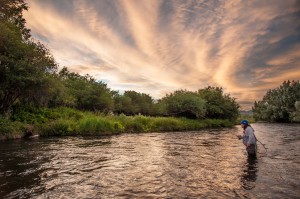Lately in the social media ‘Glass is Not Dead” is a common hash tag that’s used regarding the recent resurgence of fiberglass fly rods. I know that since I’ve used it with some frequency as of late. Long before this phrase became popular in fly-fishing circles I have been an advocate for the benefits of fishing with fiberglass, especially here in Utah where many of the rivers and streams that we fish are medium to small in nature. Although most of the major rod manufacturers make excellent graphite fly rods in shorter lengths for lighter lines, these rods don’t have the advantages or feel that glass rods do. They are smoother, have more presence in your hand and are simply more fun to fish in the right situation.

In the 70’s graphite took over as the material of choice in fly rod design and function as a result of it’s length to weight ratio. Graphite allowed rod maker to develop rods that were 8′ and longer, were incredibly light, quick and accurate compared to glass and bamboo. Conversely, fly rods built with fiberglass became quite cumbersome in longer lengths, were doggy to cast and control. Given many of the waters that we fish here in the west, having a longer fly rod led to some distinct advantages on bigger waters or when fishing from a boat. In my life time, graphite fly rods have made a significant difference in my fly-fishing experience, yet recently so have glass rods.
Not all rivers are broad, demanding and require long casts, in fact many, especially where I live are quite small. They can be densely vegetated waters where controlling a short cast is a necessity. They can present casting challenges that can’t be adequately addressed using a longer graphite rod and it’s under these conditions where short flexible glass rods really shine.
These rods are very comfortable in the hand, almost crisp and are effortless to cast in tight quarters and short distances. They also have considerably more feel when casting and are game changers with a fish on. These are qualities that I find inherent in a fiberglass rods that I don’t find in shorter light line graphite fly rods and it’s the reason why I’m so enthralled with fishing fiberglass on many of Utah and the wests less
traveled streams.
For those who have never fished or cast a short fiberglass rod, the first time you put one in your hand you’ll notice they have some weight to them. In shorter glass rods that’s an advantage when it comes to casts that are in close or when fishing lines that are light; 4wts and lighter. Once you flex these rods that weight helps create and deliver your cast and unlike graphite rods they are effortless to put a bend in. Personally I prefer a double taper fly line on these rods, but there are a number of weight forward lines that will work well also. In tight quarters, a glass rod will turn over long leaders, roll cast or even throw bigger flies easily.
In this day and age of new fly rod technology we’ve lost sight of the advantages of fly rods that are made from fiberglass or bamboo for that matter. In fact I’ve found that they not only make fly-fishing on streams where they are appropriate more fun, but they are superior performing fly rods. They have broadened my horizons, have me exploring new waters and rejuvenated many of the emotions that I felt when I first started fly-fishing.